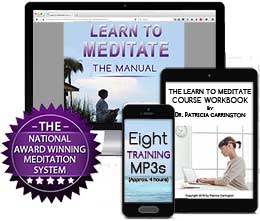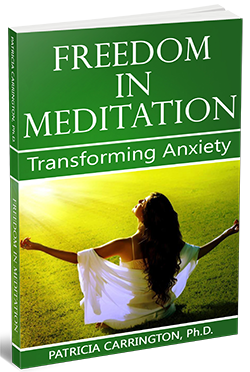Reducing Phobias with Meditation
Patricia Carrington, Ph.D.
Author of “Freedom in Meditation”
An interesting use of preparatory meditation has been reported by a behavioral psychologist, Leone Boudreau.1 A college student who had come for treatment complained of a host of incapacitating fears. He feared enclosed places, elevators, ‘being alone’, and examinations. He was so frightened by these situations, in fact, that he had been attempting to avoid them at all costs since the age of thirteen. This of course hampered him considerably on many levels. In addition, the physical symptoms of anxiety which he experienced during his panic attacks contributed to a strong fear of becoming ‘mentally ill’.
This student was first treated by ‘systematic desensitization’, the therapy in which the patient is instructed in methods of deep relaxation such as progressive (muscle) relaxation, or visualizing a calm, peaceful scene. The situations that he fears are then introduced to him, one by one (usually in verbal terms) in manageable steps. Only when he is finally able to remain calm and relaxed throughout the presentation of one step is he allowed to proceed to the next more anxiety-provoking visualization, until finally he can remain calm even when visualizing the most intense of images involving his most feared situation.
This method is frequently effective in reducing phobias which hang on even after the original emotional cause has been removed. In the case of this particular student, however, although both muscle relaxation and ‘calm scenes’ were used for systematic desensitization, the treatment had no effect on his particular phobias.
His therapist then introduced him to an even more stringent form of treatment called ‘mass desensitization’, where the patient is instructed to practice his desensitization sessions for three hours continuously on three consecutive days. Although sometimes this intensive approach works when a simple, milder method has failed, this student continued to show no improvement in his severe symptoms.
At this point the student happened to mention that he had once learned meditation and occasionally practiced it. Feeling that there was nothing to lose by trying an experiment, the therapist suggested that each day the student imagine vividly that he was in one of the situations that particularly frightened him. As soon as he had imagined his phobic scene clearly, he was to follow these imaginings immediately by one half-hour of meditation. He was also instructed that should he actually find himself in one of his fear-provoking situations, he was immediately to stop whatever he was doing and meditate for a half-hour.
The student cooperated with this plan and the results were surprising. Unlike the other techniques for desensitization, meditation was almost immediately effective. Shortly after he began to use meditation to deal with his fears the patient showed marked improvement. Within one month his need to avoid enclosed places, being alone, and elevators, had all but disappeared. What is more, since his tension level had decreased when he was in these situations, he now no longer experienced his abnormal physical sensations and this reassured him as to his physical and mental state.
This promising result suggests that meditation may be useful in treating phobias and other similar conditions.
1. L. Boudreau, ‘Transcendental Meditation and Yoga as Reciprocal Inhibitors’, Journal of Behavior Therapy and Experimental Psychiatry, 3 (1972), pp. 97–8.
Dr. Patricia Carrington’s award winning meditation technique CSM (Clinically Standardized Meditation) is a clinically sensitive meditation method developed by the Medical Department of New York Telephone Company and used by numerous medical institutions, organizations, and individuals worldwide. For information click here.






